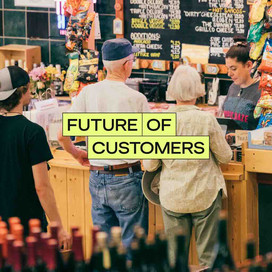Table of contents
As a restaurant owner or manager, building a successful restaurant business is your priority. But serving up delicious meals is only one part of making that reality. You have to attract and maintain a steady stream of customers to keep your business afloat, plus find ways to continuously delight and stay connected with them.
Many owners choose to start a loyalty program to engage customers and boost retention. A loyalty program is a marketing strategy where customers are rewarded for their purchases and continued engagement with a brand. The rewards may include discounts, free products or services, or points that can be redeemed toward purchases. While 42% of restaurant leaders surveyed in the 2024 Future of Restaurants report said they offer digital customer rewards programs to build loyalty, 61% of customers said loyalty program perks would interest them in a business, making it the perfect time to start one. Here are the benefits and how you can get started.
Why do loyalty programs matter?
Loyalty programs are important because they offer a number of benefits to businesses. These benefits include:
1. Improved customer experience and a sense of community
Rewarding loyalty helps customers feel valued and appreciated. For customers of New York bottle shop Craft + Carry, the brand still feels like a neighborhood bar, even though the business moved online in response to the pandemic. Dieter Seelig, the owner of Craft + Carry, says their Square-powered loyalty program has been pivotal in helping them build a community of engaged and loyal customers.
“Square Loyalty does a great job of keeping us connected with our customers. It keeps them motivated to come in again and again and make purchases,” says Dieter. “Our customers love it. They love to earn points, and they love to come in and redeem those points,” explains Dieter.
2. Higher customer retention and increased revenue
Research has shown that acquiring new customers can be a lot harder and up to 25 times more expensive than retaining existing ones. That’s more than enough reason to prioritize customer retention. But the numbers get even more interesting: If you increase customer retention by just 5%, you can produce a 25% increase in profits.
A brand’s loyal customers are not only more likely to continue buying from the brand, but they are also more receptive to new products from the brand. On average, loyalty programs boost repeat business by 40%. And they are often cheaper to manage in the long run compared to the cost of acquiring new customers.
A well-executed loyalty program can also be a self-sustaining system. Once you have established the rewards process, customers can continue to earn and redeem those rewards in perpetuity or until you discontinue the program.
3. Valuable business insight
Loyalty programs can uncover a wealth of data for your business, especially when they are backed by the right technology. You can gain key insights into your customers’ needs and preferences to optimize your offerings.
“The ability to group your customers according to what is most relevant to them, whether it’s the time since their last visit, their ordering history by item or category, or their total average sales, can be compelling,” says Rajat Deva, product marketing manager for Square for Restaurants
With Square Loyalty, for instance, you can track sales and gain insight into your loyalty program’s impact on sales. For example, you can compare average spend and visits from customers enrolled in your program versus those who aren’t.
How to start a loyalty program
Creating a successful loyalty program requires careful planning and the right tools to power the rewards system. Below are two of the most important steps to take when starting a loyalty program.
Step 1: Create meaningful rewards.
The first step is to understand what your customers want and create rewards that will be meaningful to them.
Two of the most common loyalty program rewards are:
Points-based rewards
In point-based loyalty programs, customers earn points when they make a purchase or perform certain activities, such as participating in a survey. These points can be exchanged for food items, coupons, or gift cards. For example, by signing up for your restaurant’s newsletter, the customer could earn enough points for a free coffee.
Tiered rewards
A tiered rewards system helps to create a sense of exclusivity. Each tier can have exclusive benefits, such as early access to sales or new products or access to invite-only events or experiences. Customers unlock these benefits when they reach specific purchase milestones or collect a specified number of points.
Step 2: Set up the rewards process.
Creating attractive rewards is only one piece of the puzzle. The next step is to set up the process through which customers can earn and redeem those rewards. While the process could be manual, implementing technology to automate rewards and integrate them into other parts of your business, such as marketing, is crucial in order to deliver a seamless customer experience. For Craft + Carry, combining Square Loyalty and Square Marketing solutions has helped them power and grow their program.
“One of the big advantages for us with Square is that everything’s integrated. So whether it’s the loyalty program or the marketing program, those are all baked right into the system, which works really well for us and keeps it very easy to use,” says Dieter.
What kinds of loyalty programs do customers really want?
Download Square’s 2024 Future of Customers report for innovative strategies to engage customers, from loyalty programs to new payment options.
Get the reportThe value of loyalty programs
While many businesses view loyalty programs only as a rewards system, loyalty programs can serve as much more. They can be an important way to build a deeper relationship with customers and keep them continuously engaged. The entire rewards process presents opportunities for your business to delight and stay connected with customers.
The right loyalty program can help your business build trust with customers, deliver a memorable customer experience, and deepen customers’ commitment to your brand.
![]()













